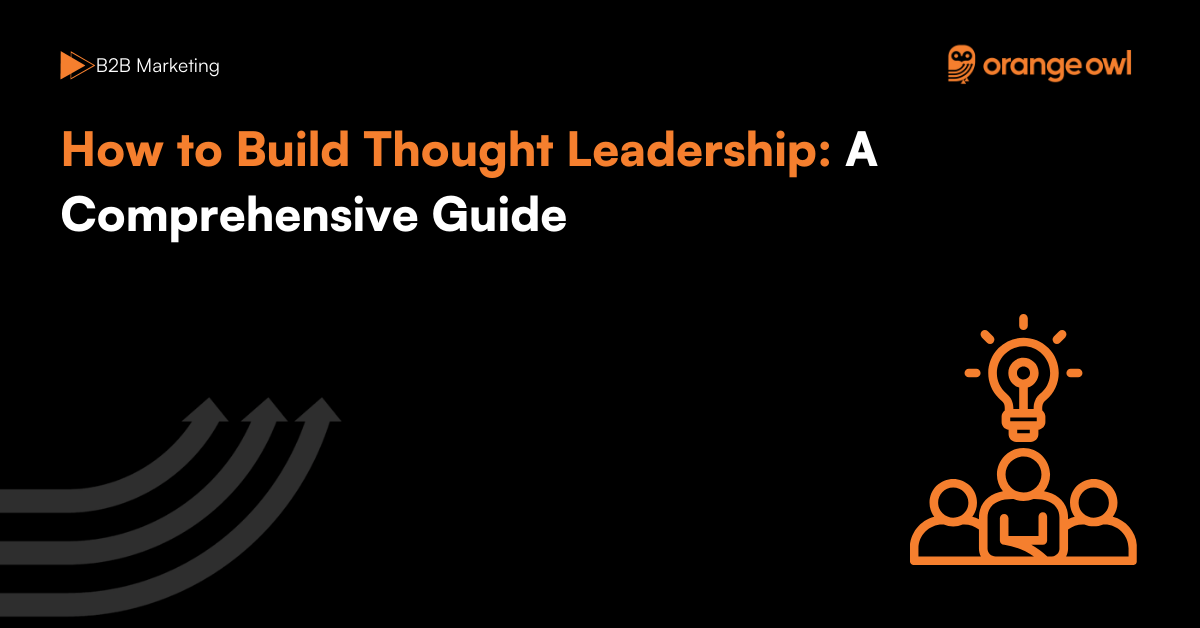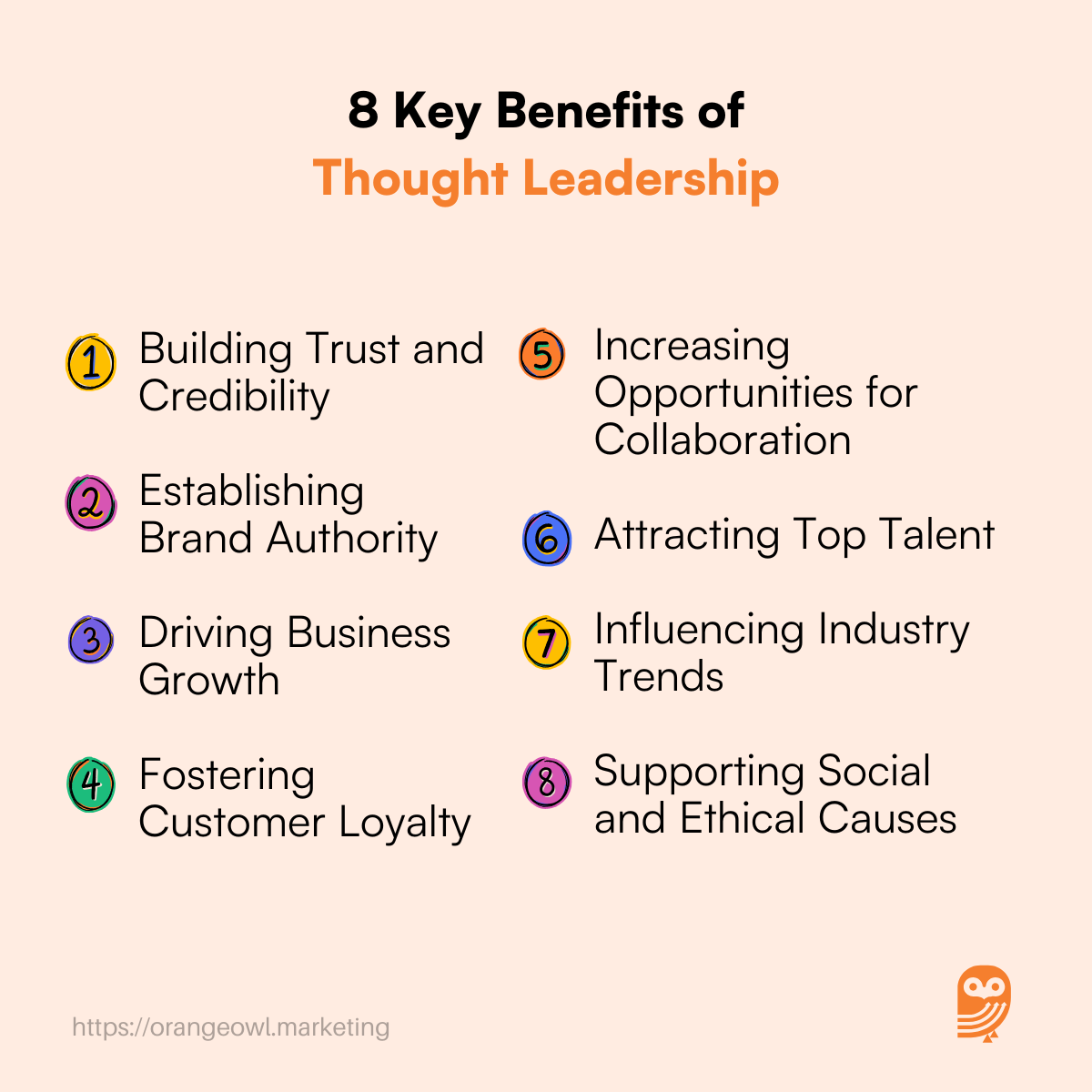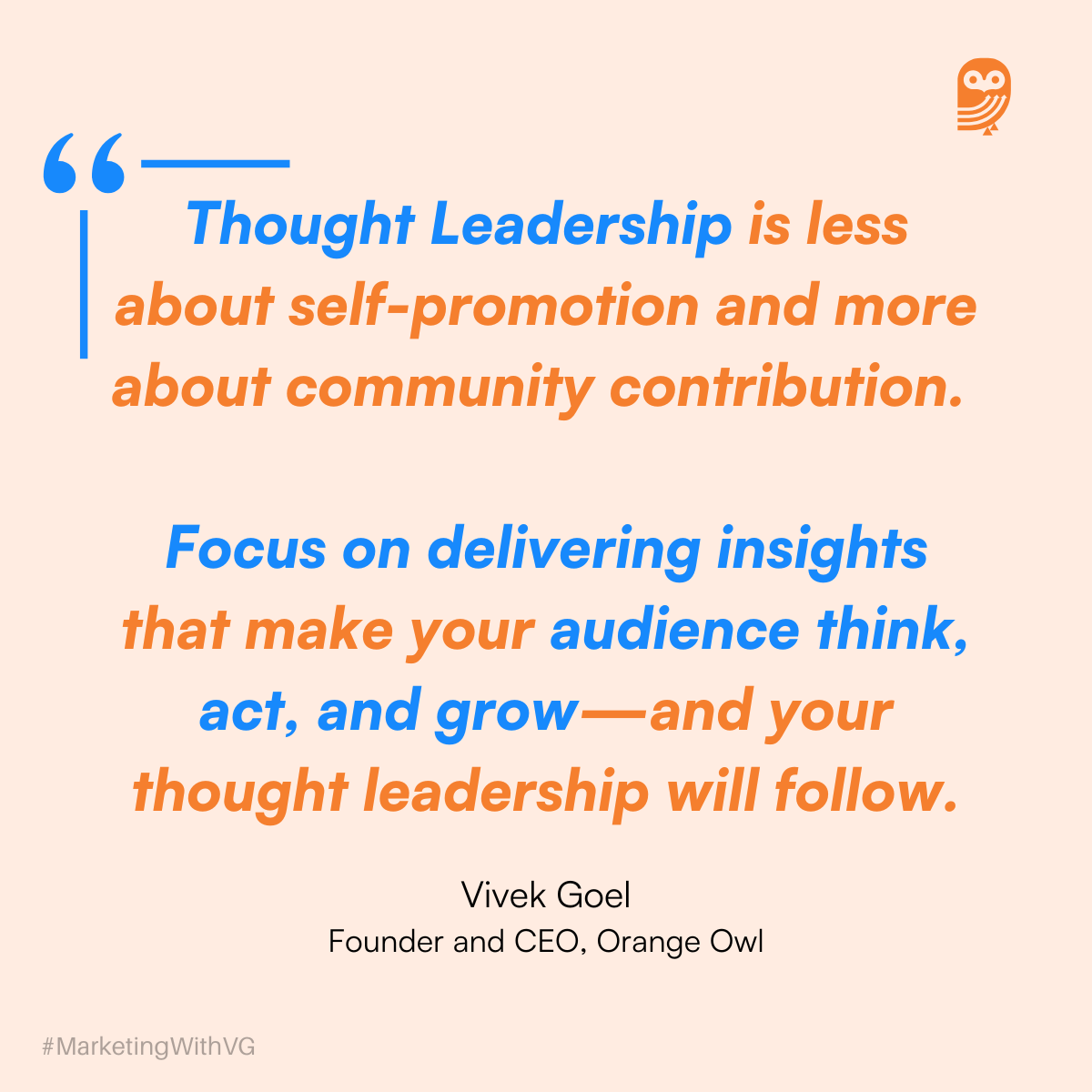How to Build Thought Leadership: A Comprehensive Guide
Vivek Goel
November 22, 2024

Table of Contents
What is Thought Leadership?
Thought leadership is the art of establishing yourself or your brand as a trusted authority and influencer in a specific field or industry. It goes beyond merely sharing expertise; it involves inspiring innovation, challenging conventional thinking, and offering unique solutions that resonate with your audience.
In the realm of B2B marketing, thought leadership plays a pivotal role in building credibility and fostering trust among decision-makers. Becoming a thought leader isn’t an overnight journey—it requires intentional strategies, authentic engagement, and a commitment to learning and adapting continuously.
Thought leadership isn’t just about being knowledgeable in a field; it’s about being a guide, offering innovative insights, and anticipating industry trends. Thought leaders are recognized for their ability to analyze past patterns, address current challenges, and predict future developments.
For example, Jake Dunlap, CEO of Skaled Consulting, notes that thought leaders contribute to ongoing conversations and set the pace for their industries by offering unique, impactful perspectives. Moreover, they embody strong leadership qualities by inspiring others to act on their insights. Walt Rakowich, a leadership expert, emphasizes that thought leaders are distinguished not just by their ideas but also by their courage to express them and their ability to motivate others.
Moreover, they embody strong leadership qualities by inspiring others to act on their insights. Walt Rakowich, a leadership expert, emphasizes that thought leaders are distinguished not just by their ideas but also by their courage to express them and their ability to motivate others.
Why Thought Leadership Is Essential in Today’s World
In an era defined by rapid innovation and information overload, the ability to establish yourself or your brand as a thought leader is more valuable than ever. Thought leadership is not just about being an expert; it’s about being a visionary who influences, educates, and inspires others within an industry. It’s a blend of expertise, authenticity, and consistent communication that transforms a professional or organization into a trusted source of insights.
For businesses, thought leadership helps build brand authority and differentiate them in crowded markets. For individuals, it opens doors to career growth, networking opportunities, and increased visibility. A well-crafted thought leadership strategy not only amplifies your voice but also fosters genuine connections with your audience, driving long-term loyalty and trust.
Whether you’re a business leader, entrepreneur, or professional, the journey to becoming a thought leader is both rewarding and impactful.
Example:
Simon Sinek, with his concept of “Start with Why,” has become a renowned thought leader, influencing leaders globally to rethink their approach to purpose-driven work. His ability to articulate ideas that resonate deeply with audiences is a hallmark of effective thought leadership.
8 Key Benefits of Thought Leadership

1. Building Trust and Credibility
Thought leadership positions you as a reliable source of information. When you consistently deliver accurate, insightful, and helpful content, your audience naturally trusts your judgment.
Example: McKinsey & Company, a global consulting firm, has built credibility by publishing in-depth reports and insights on global economic trends.
2. Establishing Brand Authority
When you lead industry conversations, you’re perceived as a pioneer. This enhances your brand’s reputation, attracting more customers and partners.
Example: Microsoft regularly releases white papers on cutting-edge technologies, reinforcing its leadership in innovation.
3. Driving Business Growth
Thought leadership drives customer engagement, leading to higher loyalty and revenue. It also opens doors to partnerships, sponsorships, and collaborations.
Example: Salesforce’s “State of Marketing” reports attract businesses looking for actionable strategies, driving demand for its CRM tools.
4. Fostering Customer Loyalty
Sharing expert advice and insights for free creates goodwill. It shows that you prioritize providing value over profit, fostering deeper customer loyalty.
Example: HubSpot’s free courses and certifications position them as a thought leader while building a loyal customer base.
5. Increasing Opportunities for Collaboration
As a thought leader, other industry players are more likely to seek partnerships or invite you to events, expanding your influence.
Example: Richard Branson’s thought leadership on innovation and entrepreneurship has led to collaborations across industries.
6. Attracting Top Talent
Companies with strong thought leadership attract skilled professionals who are inspired by their vision and values.
Example: Google’s thought leadership in technology attracts top engineers and innovators worldwide.
7. Influencing Industry Trends
Thought leaders often shape the future of their industries by introducing new ideas and solutions that others adopt.
Example: Tesla’s thought leadership in sustainable energy has influenced the entire automotive industry to adopt electric vehicles.
8. Supporting Social and Ethical Causes
Thought leaders can amplify awareness of social, environmental, or ethical issues, inspiring action beyond their industry.
Example: Patagonia uses its platform to promote environmental sustainability, strengthening its brand and mission.
7 Steps to Build Thought Leadership
1. Understand Your Audience and Industry
The cornerstone of effective thought leadership is knowing your audience and the industry landscape. Start by researching your target demographic to uncover their challenges, needs, and aspirations. Combine this with an in-depth understanding of industry trends and pain points to position yourself as a relevant and reliable resource.
Actionable Approach: Use tools like surveys, interviews, and forums to gather direct feedback. Platforms like LinkedIn Insights and Google Trends can help analyze audience behavior and interests.
Example: Neil Patel, a digital marketing thought leader, regularly tailors his blogs and videos to address common challenges faced by marketers, such as increasing website traffic or optimizing conversion rates.
2. Develop Unique, High-Value Content
Standing out as a thought leader requires producing content that offers solutions and introduces fresh perspectives. The content should reflect your expertise, creativity, and ability to tackle complex issues in innovative ways.
Content Ideas: Write blogs, whitepapers, and case studies, or create videos and podcasts. Incorporate data, examples, and actionable advice to make your content impactful.
Example: Simon Sinek’s concept of “The Golden Circle” became a hallmark of his thought leadership because it introduced a unique framework for understanding leadership and motivation.
3. Build an Online Presence
To amplify your reach, establish a robust online presence across platforms where your target audience spends time. LinkedIn, Twitter, and industry-specific forums are excellent starting points for B2B professionals.
Tips for Success: Consistently share your insights, engage with trending topics, and actively participate in discussions. Building a personal website or blog can also centralize your content and boost your credibility.
Example: Gary Vaynerchuk leveraged platforms like Instagram and Twitter to share his entrepreneurial journey, using consistent, high-quality posts to build a massive audience and establish himself as a thought leader.
4. Collaborate with Other Thought Leaders
Collaborating with established industry figures can fast-track your growth as a thought leader. Joint ventures, webinars, and co-authored content expose you to new audiences and reinforce your credibility.
Collaboration Strategies: Attend industry events to network, engage with thought leaders’ content, and propose partnerships. Look for opportunities to contribute guest articles or participate in panel discussions.
Example: Apple’s collaboration with prominent figures like Oprah Winfrey for Apple TV+ content enhanced the platform’s reputation and reach, demonstrating the power of strategic partnerships.
5. Create a Personal Brand
A personal brand encapsulates your expertise, values, and unique voice. Consistency across your online profiles, content, and interactions reinforces your authority and makes you memorable.
Key Elements: Develop a clear mission statement, visual identity, and tone of voice. Ensure all platforms—from LinkedIn to personal blogs—present a cohesive image.
Example: Elon Musk’s personal brand revolves around innovation and futuristic thinking, aligning with his ventures like Tesla, SpaceX, and Neuralink. His consistent messaging strengthens his position as a thought leader in technology.
6. Engage with Your Community
Engagement is more than broadcasting your insights; it’s about fostering two-way conversations with your audience. By listening to feedback, answering questions, and participating in discussions, you build deeper connections and trust.
How to Engage: Respond to comments on social media, contribute to forums, and host Q&A sessions or webinars. This interaction demonstrates your accessibility and willingness to help.
Example: LinkedIn’s CEO, Ryan Roslansky, frequently engages with user posts and shares company updates, creating a sense of community and trust within his professional network.
7. Measure Your Impact and Evolve
Thought leadership is a journey of continuous improvement. Regularly assess your efforts to determine what resonates with your audience and adjust your strategies accordingly.
Metrics to Track: Analyze website traffic, social media engagement, and feedback from your audience. Use analytics tools to evaluate the reach and impact of your content.
Example: HubSpot’s leadership consistently refines their marketing content by analyzing user data, ensuring they stay ahead of industry trends and maintain their thought leader status.
Strategies to Enhance Your Industry Presence
1. Collaborate with Mentors and Influencers
One of the most effective ways to elevate your industry presence is by collaborating with established mentors and influencers. By engaging in conversations with leaders in your field, you can gain valuable perspectives on trending issues and innovations. Additionally, observing how these influencers built their reputations and how they manage their businesses can provide you with insights on growing your influence.
Example: If you’re in digital marketing, collaborating with influencers like Neil Patel or Rand Fishkin can not only broaden your reach but also build credibility by association.
Action Step: Reach out to industry influencers for discussions, attend their webinars, or engage with their social media content to learn and share your thoughts.
2. Attend Networking Events and Seek Speaking Opportunities
Networking is crucial for any professional aiming to establish thought leadership. In-person events, such as conferences, workshops, or roundtable discussions, allow you to connect with like-minded professionals and potential collaborators. Moreover, speaking at such events can exponentially increase your visibility and position you as an authority in your field.
Example: Industry figures like Gary Vaynerchuk and Mel Robbins gained much of their influence by attending and speaking at high-profile events, engaging with audiences and sharing actionable insights.
Action Step: Attend major conferences in your industry, participate in panel discussions, and even volunteer to host or moderate events. These activities boost your presence while showcasing your expertise.
3. Consistently Publish High-Quality Content
Publishing regularly not only keeps you top-of-mind for your audience but also helps you demonstrate ongoing thought leadership. Whether you’re writing guest blog posts, publishing articles on LinkedIn, or creating videos, consistently putting out valuable content is key to building a strong, credible presence.
Initially, self-publishing on platforms like Medium or your personal blog can help you establish a steady flow of content. As your reach expands, consider submitting guest posts to authoritative industry publications.
Example: Influencers like Ann Handley, who is known for her expertise in content marketing, started by publishing regularly on her blog and later became a sought-after contributor for renowned publications like Harvard Business Review.
Action Step: Start with smaller blogs or platforms and work your way up. Eventually, aim to get featured on high-authority sites like Forbes, Entrepreneur, or TechCrunch. These publications can significantly boost your visibility.
4. Engage in Active Online Conversations
Apart from publishing content, actively engaging with others in your industry is vital for growing your network and influence. Respond to comments, participate in Twitter chats, and engage in LinkedIn groups where conversations relevant to your field are taking place. This interaction not only fosters relationships but also increases your visibility.
Example: Thought leaders like Shama Hyder are known for engaging directly with their community on social media platforms, answering questions, and sharing advice in real-time, which strengthens their relationship with their audience.
Action Step: Dedicate time each week to engage in industry conversations on social media platforms and industry forums. This helps position you as a go-to resource in your niche.
5. Share Your Journey and Insights Through Podcasts and Webinars
One of the most effective ways to build credibility is by providing in-depth insights through podcasts and webinars. These platforms allow you to connect with your audience more personally and establish yourself as an expert who is both approachable and knowledgeable.
Example: Entrepreneurs like Tim Ferriss and Pat Flynn grew their thought leadership by consistently offering value through podcasts, where they shared insights, conducted interviews, and provided real-life examples.
Action Step: Start your podcast or participate as a guest on established podcasts in your industry. Webinars are also an excellent way to engage with a live audience and share expertise on specific topics.
Common Mistakes in Thought Leadership

1. Focusing on Self-Promotion Over Value
Thought leadership is about inspiring and educating your audience, not about showcasing your achievements or products. Constant self-promotion comes across as inauthentic and can repel your audience. To establish trust, focus on delivering actionable insights and addressing real-world challenges.
Example: Instead of posting only success stories, share lessons learned from failures or challenges and how they shaped your expertise.
2. Lack of Original Insights
Many people fall into the trap of regurgitating widely known ideas without adding their unique perspective. True thought leadership stems from innovative thinking, challenging the status quo, or providing fresh interpretations of existing ideas.
Solution: Invest time in deep research or share insights drawn from your personal experiences and data.
3. Ignoring the Target Audience
Creating generic content without considering the audience’s specific needs results in a lack of engagement. Thought leaders often fail when they don’t identify their niche or tailor content to their audience’s interests.
Tip: Conduct audience surveys, study engagement metrics, and interact with followers to understand what resonates with them.
4. Inconsistent Content Strategy
Sporadic posting or inconsistent messaging confuses your audience. Thought leaders must maintain a coherent voice and a regular schedule to stay relevant and trusted.
Actionable Advice: Plan a content calendar, ensuring alignment across all channels, and stick to a regular posting cadence.
5. Neglecting Data and Research
Unsupported opinions can weaken your credibility. Thought leaders must use data and research to back their claims and provide concrete evidence to build trust.
Example: Include case studies, industry reports, or surveys to substantiate your insights.
6. Overlooking Engagement
Thought leadership is a two-way street. Failing to respond to audience comments, questions, or feedback gives the impression that you’re disconnected or uninterested in your community.
Best Practice: Host Q&A sessions, respond to comments promptly, and create interactive content like polls to encourage conversations.
7. Being Overly Broad or Vague
Casting too wide a net dilutes the impact of your message. A focused approach to a specific niche helps establish deeper expertise and connection.
Tip: Identify your unique niche and become an authority in that area before expanding your scope.
8. Failure to Stay Updated
Outdated opinions or reliance on old industry norms can harm your credibility. Being a thought leader means staying ahead of trends and anticipating changes in your domain.
Example: Regularly review the latest research, attend industry events, and adapt your strategies based on emerging insights.
9. Overuse of Jargon
While technical terms can demonstrate expertise, excessive use can alienate readers unfamiliar with the field. Balance accessibility with authority by simplifying complex ideas.
Pro Tip: Use analogies or practical examples to make concepts relatable to a broader audience.
10. Neglecting Metrics and Feedback
Not measuring the performance of your thought leadership efforts or ignoring constructive criticism makes it challenging to improve. Analytics can reveal what resonates and what doesn’t.
Actionable Tip: Use tools like Google Analytics, social media insights, or feedback surveys to assess your content’s impact and adjust accordingly.
Key Takeaways to Boost Your Industry Presence
Leverage social media: Platforms like LinkedIn and Twitter are essential for building an authentic reputation and engaging with your audience.
Engage with mentors and influencers: Learning from industry leaders can help you shape your thought leadership approach.
Network actively: Participate in industry events and seek speaking opportunities to increase visibility and influence.
Consistently publish valuable content: Regular content publication keeps you relevant and builds credibility over time.
Engage in conversations: Interaction with your audience and peers on social media and industry forums strengthens your authority and visibility.
Conclusion: A Lifelong Journey of Influence and Innovation
Becoming a thought leader is not a one-time achievement but an ongoing commitment to learning, sharing, and evolving. It requires staying attuned to industry trends, listening to your audience, and continuously refining your approach to provide value. Thought leadership is about creating meaningful conversations, influencing positive change, and driving innovation in your field.
As you build your thought leadership, remember to stay authentic and consistent. Authenticity fosters trust, while consistency helps solidify your position in the minds of your audience. Additionally, be open to collaboration and learning from others, as these are vital components of growth.
Example:
Consider Elon Musk’s rise as a thought leader in technology and sustainability. Through his ambitious projects with Tesla and SpaceX, he continually challenges industry norms and drives global conversations around clean energy and space exploration. His journey demonstrates the power of innovation and persistence in establishing thought leadership.
In essence, thought leadership is about making an enduring impact—on your audience, industry, and even society. Begin your journey with a clear vision and a commitment to excellence, and you’ll find that the rewards extend far beyond personal or professional success. Thought leadership is about legacy—the ideas and influence you leave behind that continue to inspire others long after.
Frequently Asked Questions (FAQs) on Thought Leadership
Thought leadership is the practice of positioning yourself or your brand as a trusted authority in your field through the consistent sharing of expertise, innovative ideas, and unique perspectives. It is important because it not only builds your reputation but also creates a sense of trust among your audience. For businesses, it enhances customer loyalty, attracts partnerships, and improves competitive positioning. For individuals, it opens doors to opportunities like speaking engagements, media features, and career growth.
The time required to establish thought leadership varies depending on factors such as your niche, the quality of your content, and your engagement strategy. On average, it may take 12–24 months to see significant recognition in a competitive field. For faster results, focus on consistent output, engaging in industry conversations, and leveraging platforms where your target audience is most active. Building thought leadership is a long-term investment that grows with sustained effort and adaptability.
Absolutely. Small businesses have an advantage because they can focus on niche areas where they have deep expertise or unique approaches. By leveraging tools like social media, blogging, and podcasts, small businesses can share authentic stories and provide real value to their audience. Participating in local events or collaborating with other niche businesses can further amplify their visibility. Consistency and authenticity are key for small businesses aiming to make a big impact.
Social media enables you to connect with a global audience, share content quickly, and participate in relevant industry discussions. Platforms like LinkedIn, Twitter, and even Instagram for visual industries are invaluable for thought leaders. To maximize impact, create a mix of original posts, articles, videos, and live sessions. Engage by replying to comments, joining industry-specific groups, and sharing others’ content with your insights. The interactive nature of social media helps build credibility and fosters meaningful relationships with followers.
The choice between personal and corporate branding depends on your goals, but a combination of both often yields the best results. Personal branding helps humanize your expertise and makes you more relatable, while corporate branding establishes trust in your organization’s capabilities. For example, a CEO who shares leadership tips alongside their company’s innovation updates creates a dual impact. Balancing both ensures that your audience connects with the individual and the brand.
Storytelling makes your message more engaging and relatable. It allows you to present complex ideas in a way that resonates emotionally with your audience. For example, instead of merely sharing statistics about a product’s success, narrating a customer’s journey of transformation using your solution creates a deeper impact. Stories are memorable and inspire action, making them a powerful tool in thought leadership to convey authenticity and inspire trust.
Events such as conferences, webinars, and panel discussions provide opportunities to share your expertise directly with a live audience. These settings allow you to address questions, network with other professionals, and gain visibility among key stakeholders in your industry. Hosting your own events or workshops can further establish your authority and foster deeper connections with attendees. Events also offer valuable content that can be repurposed for blogs, videos, and social media.
No, thought leadership is not limited to seasoned professionals. Emerging leaders or newcomers can establish themselves by focusing on specific, underexplored areas of their industry. Sharing fresh perspectives, conducting original research, or addressing common challenges in creative ways helps you stand out. Over time, your consistent efforts will build credibility, even if you’re new to the field. Thought leadership is about demonstrating value, not just years of experience.
Success can be measured through both quantitative and qualitative indicators. Quantitative metrics include website traffic, social media engagement, content shares, and follower growth. Qualitative indicators involve invitations to speak at events, media mentions, collaboration offers, and feedback from your audience. Tools like Google Analytics, LinkedIn analytics, and social media dashboards can help track progress. Ultimately, the real measure is how effectively you influence your audience and drive meaningful outcomes.
While aspects like content writing, design, or strategy can be outsourced to experts, the core insights and ideas must come from you or your organization. Authenticity is essential in thought leadership, and this can’t be fully achieved through outsourcing. Collaborating with agencies can help amplify your message, but ensure that your voice, values, and expertise are clearly reflected. Combining your expertise with external support can create a powerful thought leadership strategy.


